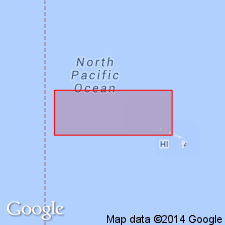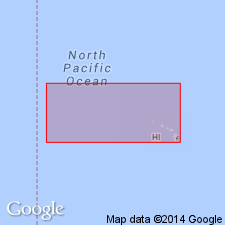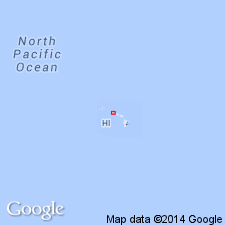
- Usage in publication:
-
- Kaohikaipu volcanics*
- Modifications:
-
- Named
- Dominant lithology:
-
- Basalt
- AAPG geologic province:
-
- Oahu
Summary:
Named for occurrence which is Kaohikaipu Island, 0.8 mi NW of Makapuu Head [Koko Head 7.5' quad] Island of Oahu. Formerly Kaohikaipu lava of Wentworth (1926). Included as unit in upper part of Honolulu volcanic series. Consists of basalt (black pahoehoe) and pyro-explosion deposits (bedded red cinders, spatter, and bombs cut by irregular dikes. Highest point of island is 80 ft above sea level. Partly underlies lithified calcareous sand dunes. Assigned latest Pleistocene and Recent age.
Source: GNU records (USGS DDS-6; Menlo GNULEX).

- Usage in publication:
-
- Kaohikaipu volcanics*
- Modifications:
-
- Age modified
- AAPG geologic province:
-
- Oahu
Summary:
Assigned latest Pleistocene or Recent age "on basis of age of other eruptions (e.g. Kaup basalt) on the same (Koko) rift line. Lack of Manana tuff on Kaohikaipu Island suggests that it is younger than the Manana tuff cone."
Source: GNU records (USGS DDS-6; Menlo GNULEX).

- Usage in publication:
-
- Kaohikaipu Basalt
- Modifications:
-
- Age modified
- Redescribed
- AAPG geologic province:
-
- Oahu
Summary:
Kaohikaipu Volcanics (Stearns, IN Stearns and Vaksvik, 1935) here called "Kaohikaipu basalt" was found to have -60-ft still-stand and resulting shoreline notch by divers of Makai Range, Inc. It is tentatively shown as peak of transgression V in late Wisconsinan time. Kaup basalt which is approx 33 ka (Gramlich and others, 1971) is either younger or about the same age as Kaohikaipu eruption. "Both lavas overlie the Manana Island tuff."
Source: GNU records (USGS DDS-6; Menlo GNULEX).

- Usage in publication:
-
- Kaohikaipu Volcanics†
- Modifications:
-
- Abandoned
- AAPG geologic province:
-
- Oahu
Summary:
Kaohikaipu Volcanics (Stearns, IN Stearns and Vaksvik, 1935) abandoned as formally named unit and called Kaohikaipu flow (and associated cone), informal unit of Honolulu Volcanics.
Source: GNU records (USGS DDS-6; Menlo GNULEX).
For more information, please contact Nancy Stamm, Geologic Names Committee Secretary.
Asterisk (*) indicates published by U.S. Geological Survey authors.
"No current usage" (†) implies that a name has been abandoned or has fallen into disuse. Former usage and, if known, replacement name given in parentheses ( ).
Slash (/) indicates name conflicts with nomenclatural guidelines (CSN, 1933; ACSN, 1961, 1970; NACSN, 1983, 2005, 2021). May be explained within brackets ([ ]).

